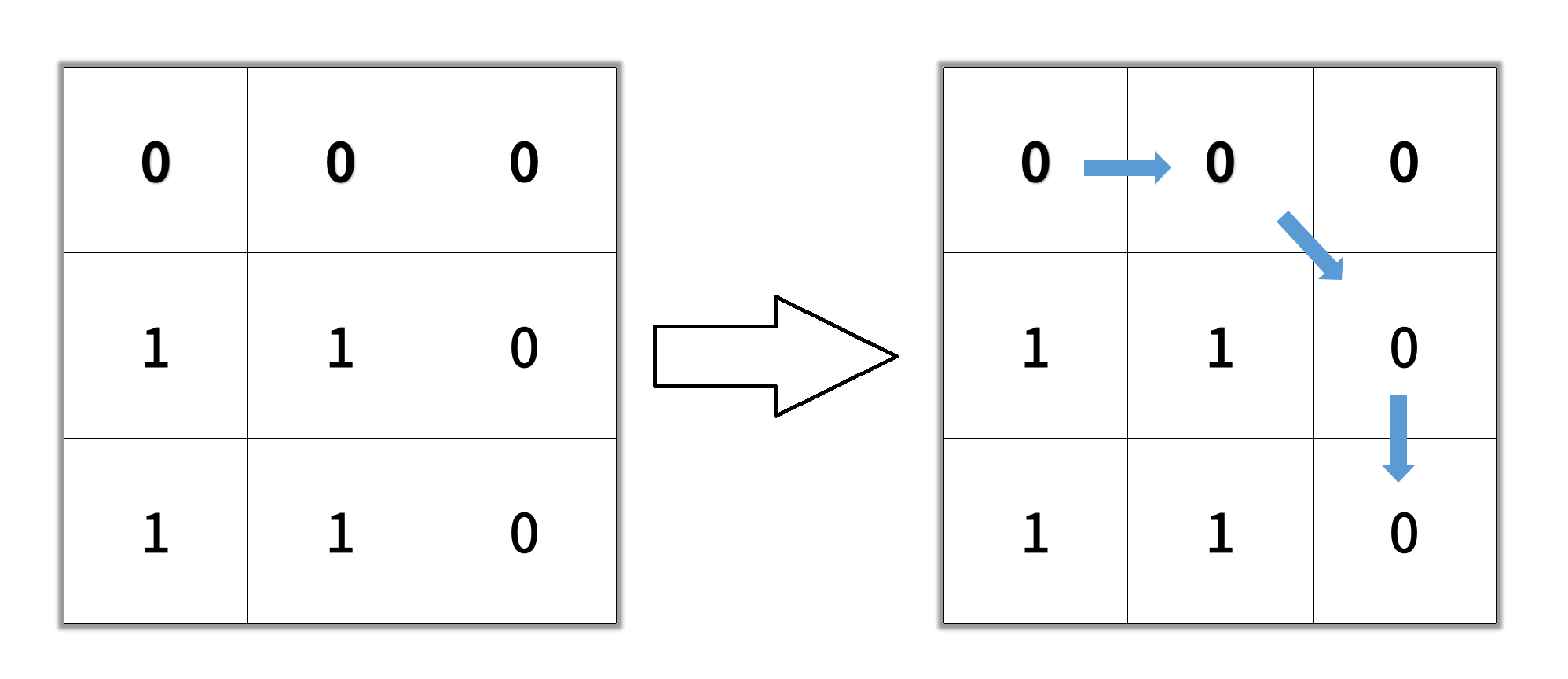티스토리 뷰
Problem
Given an n x n binary matrix grid, return the length of the shortest clear path in the matrix. If there is no clear path, return -1.
A clear path in a binary matrix is a path from the top-left cell (i.e., (0, 0)) to the bottom-right cell (i.e., (n - 1, n - 1)) such that:
- All the visited cells of the path are 0.
- All the adjacent cells of the path are 8-directionally connected (i.e., they are different and they share an edge or a corner).
The length of a clear path is the number of visited cells of this path.
Example 1:

Input: grid = [[0,1],[1,0]]
Output: 2Example 2:

Input: grid = [[0,0,0],[1,1,0],[1,1,0]]
Output: 4Example 3:
Input: grid = [[1,0,0],[1,1,0],[1,1,0]]
Output: -1Constraints:
- n == grid.length
- n == grid[i].length
- 1 <= n <= 100
- grid[i][j] is 0 or 1
Solution
n * n 이진 행렬이 주어질 때 가장 짧은 clear path를 구하는 문제입니다.
clear path는 왼쪽 위부터 오른쪽 아래까지 이동하는데 0만 방문해야합니다.
이동은 각 셀에서 8방향으로 진행할 수 있습니다.
import java.util.LinkedList;
import java.util.Queue;
public class Solution {
private final static int[][] DIRECTIONS = new int[][]{
{0, 1}, {0, -1}, {1, 0}, {-1, 0}, {1, -1}, {-1, 1}, {-1, -1}, {1, 1}
};
public int shortestPathBinaryMatrix(int[][] grid) {
int m = grid.length;
int n = grid[0].length;
if (grid[0][0] == 1 || grid[m - 1][n - 1] == 1) {
return -1;
}
boolean[][] visited = new boolean[m][n];
visited[0][0] = true; // 시작 지점을 방문처리 합니다.
Queue<int[]> queue = new LinkedList<>();
queue.add(new int[]{0, 0}); // 큐에 시작 지점의 좌표를 추가합니다.
int length = 1;
while (!queue.isEmpty()) { // 큐가 비어있지 않은 동안
int size = queue.size();
for (int i = 0; i < size; i++) { // 큐의 사이즈만큼 반복하면서
int[] pop = queue.poll(); // 큐의 head에 있는 원소를 꺼내
if (pop[0] == m - 1 && pop[1] == n - 1) { // 도착 지점일 경우 길이를 반환하고
return length;
}
for (int j = 0; j < 8; j++) { // 그렇지 않을 경우 해당 좌표에 대해 8방향을 모두 조사하면서 방문처리 합니다.
int nextX = DIRECTIONS[j][0] + pop[0];
int nextY = DIRECTIONS[j][1] + pop[1];
if (isInRange(m, n, nextX, nextY) && !visited[nextX][nextY] && grid[nextX][nextY] == 0) {
queue.add(new int[]{nextX, nextY});
visited[nextX][nextY] = true;
}
}
}
length++; // 길이를 증가시킵니다.
}
return -1;
}
private boolean isInRange(int m, int n, int nextX, int nextY) {
return nextX >= 0 && nextX < m && nextY >= 0 && nextY < n;
}
}
Test
package io.lcalmsky.leetcode.shortest_path_in_binary_matrix;
import static org.junit.jupiter.api.Assertions.assertAll;
import static org.junit.jupiter.api.Assertions.assertEquals;
import org.junit.jupiter.api.Test;
class SolutionTest {
@Test
void testAll() {
assertAll(
() -> test(new int[][]{
{0, 1}, {1, 0}
}, 2),
() -> test(new int[][]{
{0, 0, 0}, {1, 1, 0}, {1, 1, 0}
}, 4),
() -> test(new int[][]{
{1, 0, 0}, {1, 1, 0}, {1, 1, 0}
}, -1)
);
}
private void test(int[][] given, int expected) {
// when
Solution solution = new Solution();
int actual = solution.shortestPathBinaryMatrix(given);
// then
assertEquals(expected, actual);
}
}'Algorithm > LeetCode' 카테고리의 다른 글
| 1302. Deepest Leaves Sum (0) | 2022.05.27 |
|---|---|
| 329. Longest Increasing Path in a Matrix (0) | 2022.05.26 |
| 743. Network Delay Time (0) | 2022.05.21 |
| 905. Sort Array By Parity (0) | 2022.05.20 |
| 1209. Remove All Adjacent Duplicates in String II (0) | 2022.05.19 |
댓글
공지사항
최근에 올라온 글
최근에 달린 댓글
- Total
- Today
- Yesterday
링크
TAG
- 스프링부트
- spring boot app
- Spring Boot Tutorial
- 스프링 부트 튜토리얼
- Jackson
- leetcode
- Linux
- proto3
- 스프링 부트 회원 가입
- intellij
- Spring Data JPA
- @ManyToOne
- 함께 자라기 후기
- 클린 아키텍처
- JSON
- r
- 스프링 부트 애플리케이션
- 헥사고날 아키텍처
- spring boot jwt
- JPA
- 알고리즘
- Spring Boot JPA
- 함께 자라기
- spring boot application
- 스프링 데이터 jpa
- gRPC
- Spring Boot
- 스프링 부트
- Java
- QueryDSL
| 일 | 월 | 화 | 수 | 목 | 금 | 토 |
|---|---|---|---|---|---|---|
| 1 | ||||||
| 2 | 3 | 4 | 5 | 6 | 7 | 8 |
| 9 | 10 | 11 | 12 | 13 | 14 | 15 |
| 16 | 17 | 18 | 19 | 20 | 21 | 22 |
| 23 | 24 | 25 | 26 | 27 | 28 | 29 |
| 30 |
글 보관함
